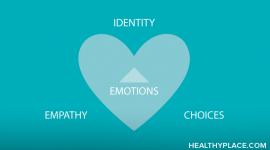Mental Health Statistics: You Are Definitely Not Alone
Mental health statistics are provide by the National Institute of Mental Health (NIMH) in an attempt to understand the scope of mental illness and mental illness treatment. These statistics on mental illness and mental health show that those challenged by a mental disorder or mental health issue are not alone. In fact, it is estimated that one-in-five adults in the United States will experience a mental illness in any given year. This mental health statistic, alone, shows how common mental illness is and with this knowledge, it's clear that no one should feel isolated because of having a mental illness.
Mental health statistics in youth are similar with 21.5% of youth ages 13-18 experiencing a severe mental illness at some point. For children ages 8-15, this number is 13% (Mental Illness in Children: Types, Symptoms, Treatments). Once people reach adulthood, the number who experience a severe mental illness in a given year is about 4.1%.
Mental Health Statistics for Specific Disorders
When it comes to specific mental illnesses, more mental illness statistics are known. Anxiety disorders such as posttraumatic stress disorder, obsessive-compulsive disorder, and specific phobias are the most common kind of mental illness in the United States experienced by over 18% of adults; this is followed by substance use disorders and depression.
Mental health statistics for specific illnesses in the United States include:
- About 16 million adults (6.9%) have had at least one major depressive episode in the last year.
- About 20.7 million adults have experienced a substance use disorder with 2-in-5 of these people having an additional mental illness (known as a co-occurring, comorbid disorder or as receiving a dual diagnosis).
- 2.6% of adults live with bipolar disorder.
- 1.1% of adults live with schizophrenia.

Statistics for the Mentally Ill in Prisons and Jails
It has been said that, in the United States, the biggest supplier of mental health treatment is the correctional system due to the extremely high prevalence of mental illness in jails and prisons. In fact, in 12-months, between 44.8-64.2% of inmates experience a mental health problem (depending on the type of correctional facility with local jails having the highest number). This is more than double or triple that seen in the community. Perhaps more alarming is that only between 17.5-33.8% of inmates have received any mental health treatment after prison or jail admission with the highest rate of treatment seen in state prisons (over federal prison or local jails).
Rates are also very high in youth offenders with 70% of youth in the juvenile justice system having at least one mental health condition and 20% living with a serious mental illness.
Mentally Ill Homeless Statistics
Not only do many people with a mental illness end up in the criminal justice system but many end up homeless as well (Mental Illness and Homelessness). The 2010 Annual Homeless Assessment Report to Congress indicates that those with a disability, particularly one relating to substance abuse or mental illness, increases one's risk of homelessness. Additionally, those with a disability spend longer times in shelters.
- More than half of adults using permanent supportive housing programs have a mental illness, a substance abuse problem or both.
- It is estimated that 26.2% of homeless adults living in shelters live with a serious mental illness.
- Approximately 34.7% of the sheltered homeless have a chronic substance abuse problem.
- Mental illnesses, either by themselves or in combination with substance abuse, are the most common disabling conditions among adults in permanent supportive housing, affecting 43% of individuals and 35% of adults in families.
Mental Illness Statistics Are Not Hopeless
While mental health statistics can seem bleak, what's important to remember is that, with treatment, people do live full, happy and successful lives even with mental health conditions including serious mental illnesses. Treatments such as different types of therapy and psychiatric medications are effective.
APA Reference
Tracy, N.
(2019, October 23). Mental Health Statistics: You Are Definitely Not Alone, HealthyPlace. Retrieved
on 2025, April 15 from https://www.healthyplace.com/other-info/mental-illness-overview/mental-health-statistics-you-are-definitely-not-alone



